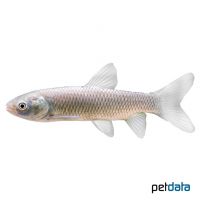Grass Carp (Ctenopharyngodon idella)
| Grass Carp Ctenopharyngodon idella | |
|---|---|
| Name | Grass Carp |
| Name Lat. | Ctenopharyngodon idella |
| Family | East Asian Minnows |
| Family lat. | Xenocyprididae |
| Order | Carps |
| Order lat. | Cypriniformes |
| Origin | Asia, Europe |
| Habitat | Rivers, lakes, ponds |
| Diet | Omnivore |
| pH | 5.0-8.0 |
| Behavior | Peaceful |
| Keeping | Group |
| Care Level | Easy |
| Reproduction | Egg scatterer |
| Breeding | Moderately difficult |
| Life Span | 10-20 years |
| Protection | No |
| Metric Units | |
| Size | 50-70 cm |
| Temperature | 4-26 °C |
| Hardness | 10-30 °dH |
| Aquarium | Ponds |
| US Units | |
| Size | 20"-28" |
| Temperature | 39-79 °F |
| Hardness | 178-534 ppm |
| Aquarium | Ponds |
Distribution and habitat
Originally, the grass carp comes from China and Eastern Siberia, but became widespread throughout the world, including Europe. They prefer to live in deep, stagnant and slow-flowing waters, such as lakes, ponds and stillwater of rivers with dense underwater vegetation
Maintenance
They require very deep, large ponds that are furnished with a soft substrate suitable for burrowing, as well as round river pebbles, and provide adequate swimming space. A light to moderate current is ideal
No ammonia, ammonium or nitrite should be detectable in the water, and the nitrate value should not exceed 100 mg/l. To ensure the water quality and oxygen content, a filter adapted to the water volume should not be missing.
Diet
They feed mainly on aquatic plants and algae. The food supply consists of a high-quality dry food (flakes, granules, pellets) for pond fish. In addition, they need plenty of plant food, such as aquatic plants, lettuce, dandelion leaves, spinach or dry food with high vegetable content (spirulina). Occasionally, some live food, such as daphnia, tubifex or mosquito larvae should be offered, which is also accepted without problems in frozen form
Regular and varied feeding promotes health and increases resistance
Behaviour and compatibility
They are lively and sociable fish that do not show any aggressive or incompatible behavior. At least 5, but preferably more Grass Carp should be kept together. They can be well socialized with other peaceful pond fish
Basically, only compatible fish species with similar requirements for water quality and water temperature should be socialized.
Reproduction and breeding
The sexes are hardly distinguishable. Males appear more slender than the more rounded females.
They spawn at a water temperature above 20 °C in strongly flowing rivers over gravelly bottoms. The larvae hatch from the eggs floating downstream after 2-3 days. The juveniles feed initially on plankton and increasingly on plants from about 5 cm in size. There are no known reports of natural reproduction in Central Europe
Life expectancy can be 10-20 years.
Important
Grass carp are very adaptable and temperature tolerant. Since they also eat higher water plants, e.g. reeds, they are often used to keep waters clear. They eat algae, but also any pond plants and are accordingly only conditionally suitable for the garden pond.
If they are overwintered in the pond, it is necessary to ensure sufficient depth and oxygen supply (filter, oxygen dispenser, ice free holder). At temperatures below 10 °C the metabolism of the grass carp slows down and no more food is accepted, accordingly feeding must be stopped. If the temperature drops further, they burrow into the mud and go into hibernation. In spring, with rising temperatures, feeding can slowly be resumed. Feeding may also be necessary during prolonged warm periods in winter
The well-being of the fish should be monitored regularly. A regular partial water change, according to the pond size is recommended, even if the pollutant load has not yet reached the upper limit. Sudden changes in water quality should be avoided. Newly introduced fish must be accustomed slowly to the water in the pond.
Further literature can be found in your pet store.
References
Text: Werner Winter; Image: petdata
Source: BMELV (1998): Tierschutzgutachten - Haltung von Zierfischen (Süßwasser); RIEHL & BAENSCH (2006): Aquarien Atlas Bd. 1, Mergus Verlag; ENGELMANN (2005): Zootierhaltung - Tiere in menschlicher Obhut: Fische; Harri Deutsch Verlag
- Gemäß § 21 Abs. 5 Tierschutzgesetz idgF
